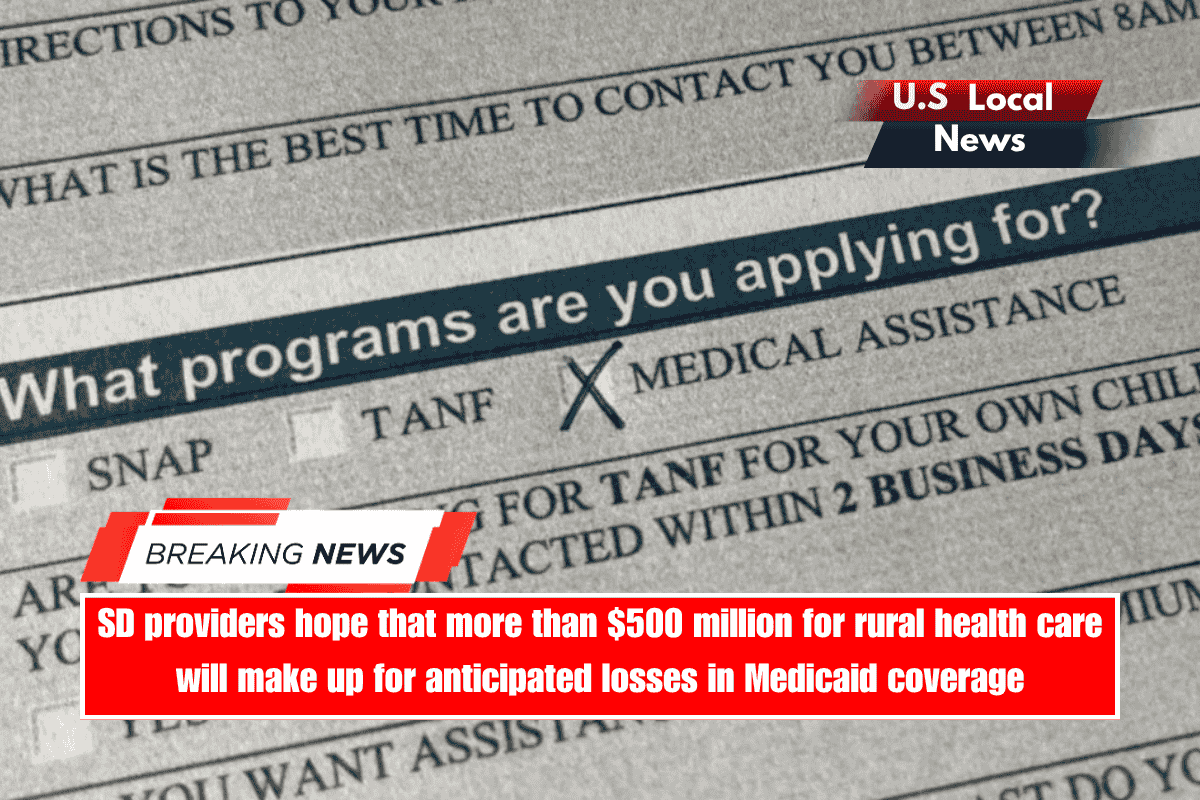An economic assistance application for the South Dakota Department of Social Services (photo illustration by Makenzie Huber/South Dakota Searchlight).
Changes to Medicaid could leave thousands of South Dakotans uninsured and jeopardize the state’s already fragile rural health care system, advocates warn. However, a concurrent $50 billion in federal funding for rural providers across the country over the next five years could mitigate the impact on the system.
That’s a “mixed bag for South Dakota,” according to Shelly Ten Napel, CEO of the Community HealthCare Association of the Dakotas.
President Donald Trump signed changes into law earlier this month as part of the One Big Beautiful Bill Act. The changes to the state-federal health insurance program for low-income people aim to eliminate fraud and waste while saving the federal government $1 trillion over a decade, according to Republicans who supported the bill. The savings will help fund Trump’s priority tax cuts, as well as new spending on immigration control and defense projects.
According to the nonpartisan health research organization KFF, 13,000 South Dakotans may lose Medicaid coverage, primarily due to failure to meet new work requirements. When combined with the expected expiration of the Obama-era Affordable Care Act’s enhanced premium tax credits at the end of this year, KFF estimates that the number of uninsured South Dakotans will rise to approximately 20,000.
Other than work requirements, key Medicaid changes have little impact on South Dakota, according to state Department of Social Services officials. According to them, the state does not rely on provider taxes that are capped by law, does not have issues with deceased or duplicate enrolled individuals, and employs a different payment model than other states. Medicaid Director Heather Petermann stated that South Dakotans should not “despair.”
“South Dakota is in a much different place,” Petermann said. “When people hear the news of ‘doomsday is coming,’ but it reflects the kinds of cuts that are occurring for states that use other types of models or mechanisms to pay for Medicaid than South Dakota does, that projects fear instead of informing people that there’s going to be a pathway for them.”
How will work requirements affect the state government and hospitals?
South Dakota had proposed its own Medicaid work requirements, but Department of Social Services Secretary Matt Althoff said the state will withdraw them now that work requirements are part of the new federal law.
By 2027, states must require able-bodied Medicaid enrollees to work or volunteer 80 hours per month or attend school at least half-time. Exemptions include those who are pregnant or postpartum, disabled, eligible for the Indian Health Service, and recently released from prison, among others.
South Dakotans voted in 2022 to expand Medicaid to adults earning up to 138% of the poverty line. According to Ten Napel, the majority of South Dakotans on expanded Medicaid either already work or qualify for exemptions.
“It’s unfortunate there has to be a lot of administrative work just to confirm that,” she told me.
The federal Centers for Medicare and Medicaid Services must issue additional guidance by the end of the year, leaving a year until the work requirement implementation guideline. Althoff said he is confident South Dakota will meet the deadline.
He’s not sure how the new requirements will affect the state’s budget, as it will necessitate an upgrade in technology and possibly more staff. The change requires Medicaid recipients to confirm their eligibility more frequently.
“That is precisely why we want to lean in to technology,” Althoff told reporters. “Can we do twice the workload of determinations with the equivalent amount of staff?”
Althoff told lawmakers on the state’s budgeting committee this month that he is unsure whether “all of the federal dollars for one-time costs will meet” the state’s Medicaid changes.
State officials are unsure how many South Dakotans will remain on Medicaid, particularly since the change requires applicants to meet work requirements for four weeks before enrolling. As of June, 29,843 South Dakota residents were enrolled in the expanded Medicaid population. There were 144,310 Medicaid recipients in the state.
Ten Napel urged caution, recommending that the state apply for an extension to ensure that the program is properly set up before it is implemented.
“Where work requirements have been implemented in other states, we’ve seen a lot of checking in and people having to remember to do it and get paperwork done,” Ten Napel told me, “and many people just drop out of coverage either because they don’t understand the requirements or because of the complexity of other things happening in their lives.”
According to Tim Rave, CEO of the South Dakota Association of Healthcare Organizations, work requirements may also be a burden on providers.
“It could take two to three years before work requirements are fully implemented,” Rave told me. “From there, if it affects us as the models predict, I believe services will be reduced or locations may close. We have to see how this all plays out and what the actual consequences are.”
Funding injections in rural health may soften cuts.
According to a statement from Sioux Falls-based Sanford Health, the law “introduces financial pressures” on health systems.
According to Rave, 20% of South Dakota hospitals have negative margins.
“Obviously, every facility will do what they can to remain open,” Rave told me. “It’ll just be a matter of what services they’ll be able to provide.”
According to Ten Napel, the services most at risk in rural areas are maternal and women’s health, behavioral health, and dental care.
People in rural areas across the country are more likely to have Medicaid health insurance, putting rural health facilities at risk of losing funding and increasing unpaid care if patients lose their coverage.
Concerns about rural health prompted the establishment of the $50 billion rural health fund in the Big Beautiful Bill Act. South Dakota will receive at least $100 million per year for the next five years, provided the state submits a “detailed rural health transformation plan.” The state could receive more depending on how the remaining funding is distributed to states.
“Our budget is smaller than most states, so disproportionately, we’re probably impacted for the good,” Rave told reporters. “It certainly doesn’t have the sting it does in other states.”
KFF predicts that states with expanded Medicaid and a higher proportion of rural residents will see the greatest decreases in federal Medicaid spending. While Kentucky will suffer the most, losing $12.3 billion, federal Medicaid spending in rural South Dakota is expected to fall by $487 million over the next decade. According to KFF, questions remain about how the funding will be distributed among the states.
The state and health-care providers intend to collaborate on how to use the funds. Ten Napel stated that the funds can be used for training, recruitment, and improving access to preventative and primary care in rural areas.
“How do we invest these resources so that in 10 years, we’re in a better place than we are today?” Ten Napel explained. “We know investment in the front end can save money on the back end.”
However, Sanford representatives believe that funding alone will not fully address the broader challenges that rural providers will face.
“We look forward to working closely with our state and federal elected officials,” according to a statement, “to implement these changes in ways that protect access, support innovation and strengthen care for rural America.”









